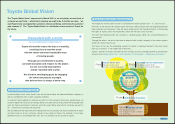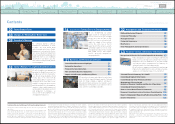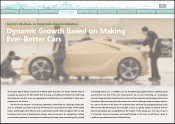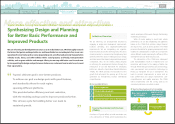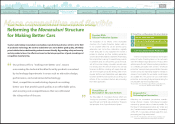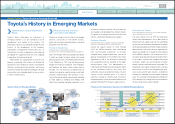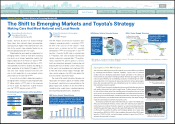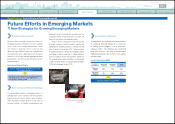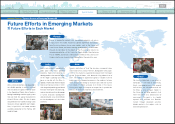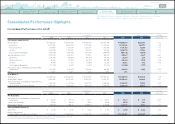Toyota 2012 Annual Report Download - page 12
Download and view the complete annual report
Please find page 12 of the 2012 Toyota annual report below. You can navigate through the pages in the report by either clicking on the pages listed below, or by using the keyword search tool below to find specific information within the annual report.
Management and
Corporate Information Investor Information
Changes for Making
Ever-Better Cars
Toyota Global Vision Business and
Performance Review Financial Section Special FeaturePresident
ʼ
s Message Medium- to Long-Term
Growth Initiatives
TOYOTA ANNUAL REPORT 2012
More effective and attractive
The New Avalon
- Developed in North America -
The top-of-the-line Toyota Avalon debuted in the US in
1994, and Toyota revealed the fourth-generation 2013
Avalon in April 2012, at the New York International
Auto Show. The new 2013 Avalon is the result of a
North American-focused design and engineering
effort led by a youthful and talented team at the Calty
Design Research Inc. facilities in southern California.
It is a true example of the regionally-led management
aimed for in the Global Vision.
Made-in-China Hybrid
- Hybrid Technology to Make Chinese Customers Smile -
Making their world premieres at the 12th Beijing
International Automotive Exhibition in April 2012
were the
“
Yundong Shuangqing
,
”
a China-only
concept hybrid equipped with a hybrid system
developed primarily at the Toyota Motor Engineering
& Manufacturing
(
China
)
Co., Ltd. R&D Center in
Changshu, China, and the compact-sized
“
Toyota
Dear
Qin
,
”
which is a global-strategic concept
(
sedan
and hatchback
)
featuring a design aimed at attracting
more people to the user base. Toyota will continue
to make ever-better cars, from eco-cars through
specially adapted vehicles and sports cars, that will
make our customers smile by contributing to richer
lives and better communities in China.
Enhancing the Development
Structure
Toyota is moving forward with improving development
capacity, localized carmaking, and organizational/
structural improvements so as to improve our structure
for continuously producing better cars.
To improve development capacity we have set
a target of 30% improvement in development
capacity* for the end of 2012 compared to 2009 by
improving all the factors involved in development, such
as development tools (design, prototypes, testing),
processes, and human resources/ability. We are also
improving development efciency by increasing the
authority of the chief engineers (CEs), who are in closest
proximity to consumers and who coordinate model
development. This will improve development efciency
by speeding up the decision-making process.
Toyota is placing regional general managers in
charge of localizing carmaking in each region, and, by
developing ties with local sales and R&D units, Toyota
can ascertain the needs of each market and improve
both quality and product appeal.
Our organizational structure improvements center
on making the CE the overall coordinator in vehicle
development, with responsibility for each area of technical
development, so as to foster specialized technologies
and long-term development leading to the ever-better
cars envisioned by the CEs. As the overall coordinator of
vehicle development, the CE also has a say in the vehicle
Conducting “grouping development” on the platforms
for economies of scale established through the TNGA
provides for part and unit standardization for better
efciency and lower costs in development. It is up
to the manufacturing technology units to adopt this
approach and bring the technologies together to
develop blueprints and manufacturing processes with
the highest possible performance and functionality so
as to develop parts that are standardized for sharing
among a number of models. Adopting a similar
approach in the procurement eld means continuing to
gain the benets of an economy of scale by conducting
parts ordering that straddles regions, models and
launch periods. From the twin perspectives of quality
assurance and improving international competitiveness,
parts standardization must be conducted jointly with
suppliers. Parts standardization also leads to increases
in the production volume of each part, making it
possible to diversify suppliers and production sites
without losing efciency. This enables stable supplies
even during emergencies, thereby strengthening the
supply chain.
Supply-chain Enhancement
to Diversify Risk and Improve
International Competitiveness
design evaluation and testing conducted in-house.
*R&D staff members x hours
Toyota’s Medium- to Long-Term Growth Initiatives
Ⅰ
: Innovation in development, design and procurement-2
Enhance Development Capability and Supply Chains to
Improve International Competitiveness
Search NextPrev page 12
Contents
0821


